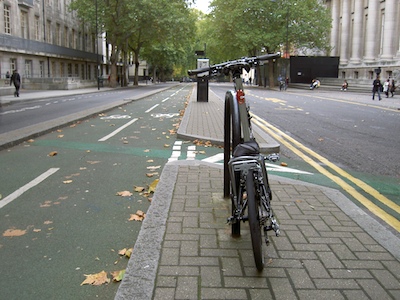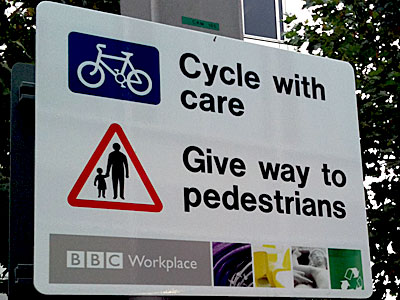Traveling often shifts your worldview, changes perspectives, and the way you look at things. Back from the Mobile Social Worldwide, I’m just starting to parse all those thoughts into posts. I’ll get to stopping for a Holy Man and riding a Bubble of Curiosity in Delhi later.
Reading about Living Streets in Colorado, reminded me of the ride and talk I had with Brian Deegan in London. He expressed the struggle it was to get to this point with Camden’s bike lanes, bike tracks, and lights. Camden is a model for cities elsewhere, but Brian and his firm still fight politics and also public awareness.
London has this thing for signage – signs everywhere for everything – and it’s a bigger battle to sign a new bike track than build one. We watched as cyclist after cyclist rode right by the entrance to a bike track because they didn’t know it was there.

London cyclists ride past this entrance to the Bike Track – putting the Dahon there didn’t help either.
Brian deals daily with people like Vincent Carroll of the Denver Post who think that yes our urban sprawl is bad, but we need more roads and just for cars. Vincent opposes the Denver Living Streets initiative that wants to rethink and build the Mile High City around people and not cars. They’ll do that in part by reducing and calming streets and encouraging people onto mass transit, bicycles, and walking.
Such complacency from a federal agency is downright alarming. What if people can’t afford to move closer to their jobs or can’t find one closer to home? What if they resent wasting an extra half hour or more in traffic on unavoidable trips? Living streets? By all means. But not at the price of personal mobility.
To Vincent, personal mobility means his car and those streets are dead to everything else.
I don’t know if we’ve got the energy to overcome car-centric thinkers like Vincent – that baby-boomer generation spent much of their lives on Interstates. We may have to wait until people like Vincent retire and give us cyclists the right-of-way.
Priorities
David Byrne’s Bicycle Diaries and lecture series earlier this year, focused on the livable city. He compared riding in the States v. abroad. On riding his bike in various cities, David writes:
Through this window I catch glimpses of the mind of my fellow man, as expressed in the cities he lives in. Cities, it occurred to me, are physical manifestations of our deepest beliefs and our often unconscious thoughts, not so much as individuals, but as the social animals we are. A cognitive scientist need only look at what we have made–the hives we have created–to know what we think and what we believe to be important, as well as how we structure those thoughts and beliefs. It’s all there, in plain view, right out in the open; you don’t need CAT scans and cultural anthropologists to show you what’s going on inside the human mind; its inner workings are manifested in three dimensions, all around us. Our values and hopes are sometimes awfully embarrassingly easy to read. They’re right there–in the storefronts, museums, temples, shops, and office buildings and in how these structures interrelate, or sometimes don’t. They say, in their unique visual language, “This is what we think matters, this is how we live and how we play.” Riding a bike through all this is like navigating the collective neural pathways of some vast global mind. It really is a trip inside the collective psyche of a compacted group of people. A Fantastic Voyage, but without the cheesy special effects. One can sense the collective brain–happy, cruel, deceitful, and generous–at work and at play. Endless variations on familiar themes repeat and recur: triumphant or melancholic, hopeful or resigned, the permutations keep unfolding and multiplying.
In Prague, we zipped around the city on a Soviet-era subway system that was on-time, efficient, and took us where we needed to go in about 20 minutes. I also rode the city on bike paths, cobbled streets and by tourists with a network of trolleys passing me.

Back at Seatac Airport, one of the first conversations I had was with a traveler from Korea who was looking for the taxi queue. I said, “it’s out here, up this escalator, across the bridge over all the cars, and inside of the parking garage, down another escalator, and again across the path of all the cars. You see here in the State we built our country for the car. Cars are closest to the entrance and exits.
Walk out of Seatac, pulling a folding bike in a suitcase behind you, and you’ll see what matters to us in the States: the car.
Related
Bicycle Diairies quote reprinted by arrangement with Viking, a member of Penguin Group (USA) Inc., from BICYCLE DIARIES by David Byrne. Copyright © David Byrne, 2009
…We're riding townies, adventure, and mountain bikes. Find recommendations on our store page. As Amazon Associates we earn from qualifying purchases.
